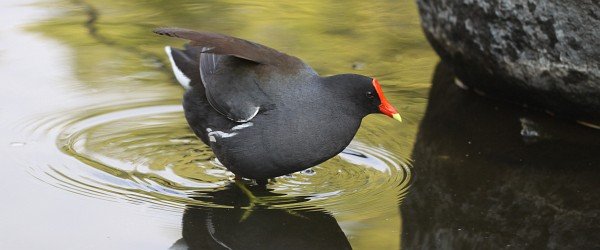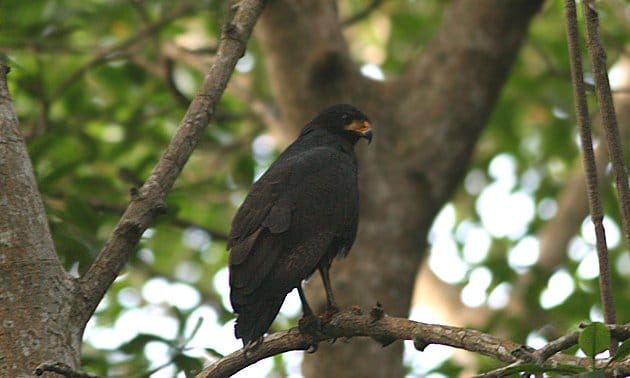One of the items currently before the American Ornithologists’ Union’s North American Checklist Committee (NACC) is a proposal to split Old World and New World forms of the Common Moorhen (Gallinula chloropus) into separate species. The AOU’s South American Checklist Committee (SACC) passed a very similar proposal last year, and the IOC followed suit shortly thereafter. I expect the NACC will pass the proposal this year, and the Clements list will follow, so let’s look at some of the reasons for this split — and the touchy subject of English names for the New World species.

Common Moorhen … or is it? © Corey Finger
Old World and New World moorhens haven’t always been lumped. The AOU treated New World populations as “Florida Gallinule,” Gallinula galeata, in its first checklist (1886) but lumped them into the widespread Old World species in its 18th supplement (1923), between the third and fourth versions of the checklist. Despite the lump, the AOU kept the English name “Florida Gallinule” at first, eventually replacing it with “Common Gallinule,” and finally changing this to “Common Moorhen” to conform with Old World usage in the 1982 34th supplement. This all happened before I was born, so “Common Moorhen” is all I’ve ever known, but I know birders who still struggle with the change.
Alvaro Jaramillo’s proposals to the AOU checklist committees cite recent genetic work and analysis of the birds’ vocalizations to support species status for the two forms.
A 2008 paper by Groenenberg et al. (Ancient DNA Elucidates the Controversy about the Flightless Island Hens (Gallinula sp.) of Tristan da Cunha) set out to examine status of two flightless moorhens from the mid-Atlantic islands of Tristan da Cunha and Gough. In the process, researchers discovered that the two species, one of which is extinct, are more closely related to Old World Common Moorhens than to those sampled from the New World.
On one hand, this can be interpreted as evidence that four species are involved. On the other hand, it’s not at all impossible to think that members of a very widely distributed species could become isolated in remote environments and diverge while the rest of the population maintains reproductive compatibility. However, these results also seem to show genetic distance between Old World and New World forms consistent with isolation, though the number of individuals sampled was not very high.
Vocalizations differ markedly between Old World and New World populations, with New World birds known for their weird cackling and giggling noises, while the calls of Old World birds are briefer and simpler (and less likely to end up in a spooky soundtrack). Xeno-canto has recordings from all over the world for comparison: Common Moorhen. Vocalizations are often important clues in birds’ relationships because they are so important in birds’ social interactions and reproduction.
The most obvious physical difference between the two forms is the shape of the birds’ red forehead frontal shields, nicely illustrated below in photos by Charlie and Mike.

This bird, photographed in the UK by Charlie Moores, shows an elliptical, rounded frontal shield.

This bird, photographed in the Bahamas by Mike Bergin, shows a wedge-shaped frontal shield, wide and flat at the top, tapering toward the base.
So to sum it up, the Old World and New World forms appear to show some genetic distance, at least in one recent study, and they show vocal and modest physical differences. Presumably, they do not have much, if any, natural opportunity to interbreed anyway. The trend these days is to split in such cases, so such an outcome seems logical here too.
But what are the English names for the species after they are split? Both the SACC and the IOC use Common Gallinule for the New World species, reverting to a name many birders still use anyway. The IOC keeps Common Moorhen for the Old World species, which has never really been much in question anyway, as far as I know.
In fact, the SACC had already reverted to “Common Gallinule” even before the split, which you can read about in the ranty and rather amusing Proposal #335. “Those who don’t care about the taxonomy think that the name Moorhen itself is totally absurd,” writes Van Remsen. “The species has nothing to do with moors, per se, and even if it did, we don’t have any gosh-darned moors in this hemisphere.”
Again, the switch happened before I was born, so I don’t get the drama at all, but to Van’s point about moors, there may be another explanation. The Wikipedia Common Moorhen entry cites The Oxford Dictionary of British Bird Names (1993) to say that “moor” here is used in an obsolete sense meaning “marsh.” I don’t have access to a copy of the work to check, but it sounds plausible.
In any case, the word has a fine Old English roots, and certainly doesn’t need to change on the east side of the Atlantic. “Gallinule” is a Neo-Latin creation (originating from the word for “hen”) and for whatever reason has a lot of traction over here.
It seems likely that the AOU NACC will also split the species and call the New World birds “Common Gallinule” — after all, this is simplest and actually has precedent, unlike some of the more novel suggestions. Just for fun, which of these names do YOU prefer, and why? Leave a comment!
- Common Gallinule
- American Moorhen
- Laughing Gallinule
- Florida Gallinule
- Other — please specify!




 New writers welcome – please contact us for details.
New writers welcome – please contact us for details.

















Red-fronted Laughing Moor-Gallinule.
Naming rights between the Old World and New World for international birds are always amusing. You all should be grateful that you aren’t in new Zealand, where if there is a conflict between Kiwi names and anywhere else’s then everywhere else’s wins every time. Even for endemics.
“Moor” is the German word for any form of swampy wetland (bog, mire, marsh,… we don’t differentiate that much, and if we do, we add something to the word “Moor” instead of using a different word).
I don’t think the “Common” part makes sense as I have never been to an area in North America where the bird was common. In fact, many birders around Ann Arbor jokingly called the bird “Scarce Moorhen”. And of course you’ll want to drop the “Moorhen” for the reasons listed in the post.
Therefore, I am with John but would just like to suggest a slight alternative:
Red-fronted Laughing Florida-Gallinule
Laughing Gallinule. Ever since I heard that name I have liked it.
@Jochen, you’d be surprised at how common this moorhen can be. Finding one in the northeast in summer has never been a problem.
But Laughing Gallinule is certainly evocative. Using Gallinule would align the species with its more charismatic purple cousin.
Coca-Cola-Pepsi-Budwiserhen.
Look I found a new way to raise funds for conservation!
@Mike: I presume it’s equally common around Ann Arbor but just more difficult to see through the mist of migrating warblers, particularly Kirtland’s. Great Lakes, right? GREAT lakes! 😉
I don’t like terms like Common or Lesser for any living being.
I’d reserve the Moorhen for the Old World species, since the term Moor is still in use over there.
Florida? It’s an abundant Bird and not specific to the state – so that makes little sense.
Laughing? Naah – that term never comes to mind when hearing them. Complaining would suit her call better as a description – but that would be as wrong as laughing as I’m pretty sure the bird expresses neither.
So I end up with American Gallinule as the one making the most sense.
@Jochen: The Ann Arbor moorhen fanciers should have driven up to Maple River SGA on 127. There was a hen parading her chicks around in full view right off one of the dikes for a few weeks last summer. We probably have them here in Lansing as well, but the shrouding mist here is smog, not warblers.
@Kirby: I guess they attempt breeding each year at Dolph but their chicks get eaten by migrating Connecticuts every time! 🙂
Still my nemesis around Ann Arbor, Jochen, believe it or not.
American Gallinule.
@ Laurent
A couple years back Trinkle Marsh had one. I guess this means you could still pull ahead of me for Washtenaw County!
In the spirit of Will’s suggestion, I propose Lady Ga-Gallinule.
In keeping with its more colorful cousin, perhaps Gallinula galeata should become Gray Gallinule.
@Laurent: seriously, as far as I know Dolph had a breeding pair at least in 2005 and might be your best bet around AA. I think I only ever saw them in Ontario, but then I didn’t particularly search for them in Washtenaw.
@John: what?? Are you “dropping me like a hot potato” as we say in German? I thought we were in this together. Oh well, come on, give me at least a “Red-fronted Laughing Gray-Gallinule”.
@Duncan: no way! Maybe Deep Purpinule, but that’s as far as I’d want to go.
Jochen, as far as I remember, you saw some Moorhens with me in Monroe County, at Pointe Mouillee (that was a lifer for me). My issue is in Washtenaw County, if I don’t find a way to see it this year, Sarah T might pass me on the ebird ranking, as she is constantly gaining on me!!!!
What’s about “squarred-fronted gallinule”, or “trumpeter gallinule”?
@ sarah…I still have a few easy ones to find to stay safe for 2011……
@Laurent: yes, right, Point Moo!
Love the idea of Deep Purpinule as an old fan of the band! Anyway, I was glad of the split for another armchair tick.
Florida False-Coot
Since I’ve seen these birds in California, Texas, Georgia, and both coasts of Mexico, Florida in the name would be a misnomer. I have at least 16 birds in my list whose name starts with American, including the American Coot, which is in the same family. Even though Common Gallinule is not the best description, at least it would be easier to find in my list since Common Moorhen is probably what will always come to mind and is used in at least one of my books.
Not a big fan of anything being named “Common”, “Lesser” or “Intermediate”. A name should reflect something physical about the species, unique about its natural history or named after prominent Rugby stars.
While looking at moorhens in Brazil, I’ve noticed some behavioural differences between Old World and New World forms as well, with Brazilian birds apparently more social and even more aquatic in their feeding habits (http://www.leedingain.com/2011/12/brazilian-moorhens-laughing-matter.html). I’m wondering North American birds compare in terms of this behaviour?
American Moorhen, no doubt.
I am a new lover of the Moorhen, as we have a family in our yard, living in a tree on the marshy lake for the last 4 years. Mr. and Mrs. have raise 18 babies in 4 years and lost 9 others to “disappearances” aka predators (I take pictures whenever they have babies-she is sitting on eggs right now in my bottlebrush tree). They raise them until they turn black and then chase them off to a tree down the lake. I say it’s absolutely a Moorhen, forever in my mind. Since this family, I have now started seeing them in every wetland/marshy/lakeside wherever I go (South Florida-Broward County). Therefore, I would go with American Moorhen since it is not specific to Florida only, they don’t laugh, and in many places they are scarce – not common. They are also not common in the behavioral sense, different than any other birds I have observed over long periods of time-even the plentiful marsh-living birds in my backyard/lake or frontyard/certified wetlands. Their behavior seems different than any other category of my birds and they are much more people friendly while being highly possessive and aggressive towards certain other birds when nesting. they can scare the biggest birds and ducks in the area with one sqwaaak and running at them or escorting a group of mallards away from the tree with a sqwaak and jumping into the water and swimming behind them for about 15 feet. All the other birds are in groups by behavior, easy to tell by observing – except the Moorhens. As a side note, I mentioned “people friendly” because if I come across worms or big bugs while gardening I’ll grab them and go over to the tree and make one of 2 sounds, smooching sounds, like a kiss or “tink tink tink” like a fork on a glass bowl and if I wait, Mr. will swim over and jump on the half seawall and I will toss him the worm or bug. It took awhile for him to figure out the sound would get him fresh food but he will either eat it right there or swim around to the nest and hand it over to Mrs. or break it up and feed it to the babies himself. If it’s anyone else but me, he is skittish and won’t risk it, but he comes out for me and occasionally will come out even if my husband is there.
Anyway, none of the other names fit for me. I’m a year after this conversation so its probably done already but common, laughing, Florida don’t fit and Gallinule just doesn’t fit them like Moorhen does!
It’s all over the New World not only in America so the same argument for not having Florida in the name applies equally to not having America in the name.
DOES ANYONE KNOW THE FUNCTION OF THE FRONTAL SHEILD OF THE GALLINULE AND COOT?
Isn’t the new world the Americas (North and South)?